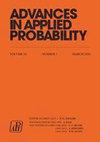Upper large deviations for power-weighted edge lengths in spatial random networks
IF 1.2
4区 数学
Q3 STATISTICS & PROBABILITY
引用次数: 1
Abstract
We study the large-volume asymptotics of the sum of power-weighted edge lengths $\sum_{e \in E}|e|^\alpha$ in Poisson-based spatial random networks. In the regime $\alpha > d$ , we provide a set of sufficient conditions under which the upper-large-deviation asymptotics are characterized by a condensation phenomenon, meaning that the excess is caused by a negligible portion of Poisson points. Moreover, the rate function can be expressed through a concrete optimization problem. This framework encompasses in particular directed, bidirected, and undirected variants of the k-nearest-neighbor graph, as well as suitable $\beta$ -skeletons.空间随机网络中功率加权边长的上大偏差
研究了基于泊松的空间随机网络中幂加权边长度和$\sum_{e \in E}|e|^\alpha$的大体积渐近性。在$\alpha > d$状态下,我们提供了一组充分条件,在这些条件下,上大偏差渐近特征为凝结现象,这意味着过量是由泊松点的可忽略部分引起的。此外,速率函数可以通过一个具体的优化问题来表示。该框架特别包含k-最近邻图的有向、双向和无向变体,以及合适的$\beta$ -骨架。
本文章由计算机程序翻译,如有差异,请以英文原文为准。
求助全文
约1分钟内获得全文
求助全文
来源期刊

Advances in Applied Probability
数学-统计学与概率论
CiteScore
2.00
自引率
0.00%
发文量
64
审稿时长
6-12 weeks
期刊介绍:
The Advances in Applied Probability has been published by the Applied Probability Trust for over four decades, and is a companion publication to the Journal of Applied Probability. It contains mathematical and scientific papers of interest to applied probabilists, with emphasis on applications in a broad spectrum of disciplines, including the biosciences, operations research, telecommunications, computer science, engineering, epidemiology, financial mathematics, the physical and social sciences, and any field where stochastic modeling is used.
A submission to Applied Probability represents a submission that may, at the Editor-in-Chief’s discretion, appear in either the Journal of Applied Probability or the Advances in Applied Probability. Typically, shorter papers appear in the Journal, with longer contributions appearing in the Advances.
 求助内容:
求助内容: 应助结果提醒方式:
应助结果提醒方式:


